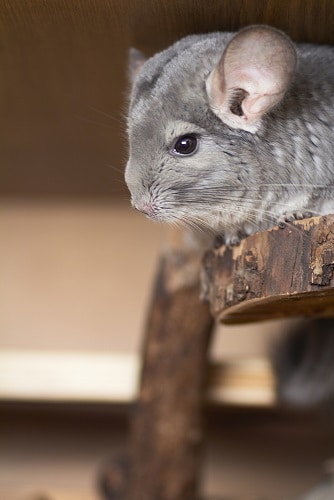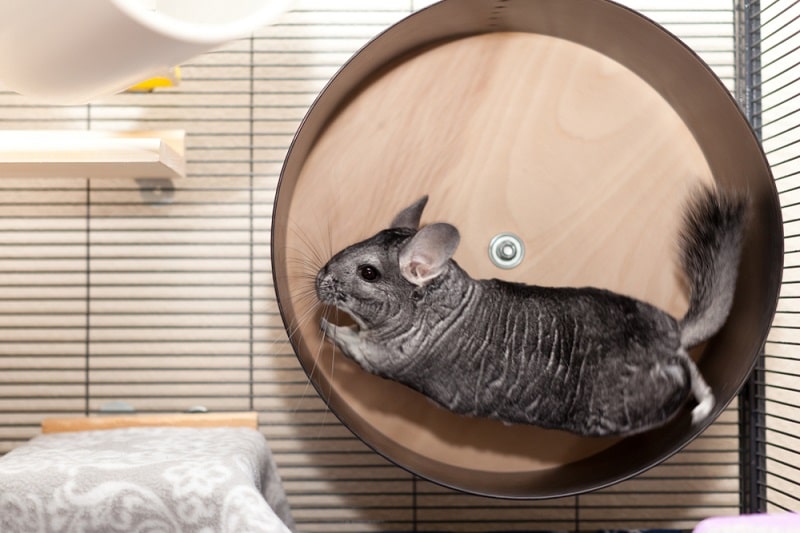
Regular out-of-cage exercise is ABSOLUTELY NECESSARY for maintaining the health and happiness of your pet chinchilla, please see Chuffy’s story. Under normal circumstances a healthy chinchilla can have unlimited exercise, it is NOT dangerous or harmful as long as some basic, common-sense precautions are observed.
Chins should ALWAYS be kept in a climate-controlled environment, with both temperature (60-70°F) and humidity (40-60%) kept low. This will allow them to get the exercise they NEED all year around.
It’s advisable to begin by bonding with your new chin first so that he is used to being picked up and handled by you before giving him out-of-cage exercise time. Otherwise, it may be difficult to get him to behave when it’s time to return to his cage. An exception to this would be if the chin was neglected by his previous owner by being denied exercise. This can make some chins hostile to people and being handled by them until they are first shown that they will ALSO be allowed freedom (out-of-cage exercise) on THEIR terms.
Exercise time is THE time for interacting with chinchillas, if you don’t have time for it, please consider rehoming, because constant confinement without relief for such intelligent, naturally active creatures is simply cruel.
Exercise and Environmental Stimuli
Unfortunately, in recent years, a few prominent pet breeders have begun carelessly criticizing exercise and suggesting that chinchillas should have their exercise limited “for their own good.” The people who advise this are apparently naively unaware that most pet chins already ARE under-exercised. It’s a serious problem that rescuers internationally can attest to as a result of seeing scores of maladjusted, poorly chins that have suffered from being allowed little to no out-of-cage exercise for sometimes years before being discarded at the rescue. “No time for my chin” is one of the top three reasons that chins are surrendered to rescue.
Sometimes the advice to “limit exercise” is a lie of convenience, because exercising a large herd of breeding chins can be very demanding and time-consuming, so it’s easier to justify negligence by pretending the chins don’t need exercise than it is to try to give them the exercise they fundamentally need and deserve. Other times exercise is ignorantly blamed for problems that occur during playtime, such as seizures and accidents associated with not chin-proofing, supervising, or acknowledging territorialism. Such problems are NOT THE FAULT OF EXERCISE itself and no chin should be punished by having their exercise limited to compensate for their owner’s lack of diligence in observing basic, often common-sense precautions.
Pet chinchillas are PETS, not livestock and as such, they’re entitled to better treatment than they got on fur farms, or “ranches.” Even though ranches neglect exercise because they prioritize business interests over the chins’ need for exercise, they too know that exercise is fundamental to chinchilla health and well-being. Chinchillas.com, associated with the Ritterspach ranch that’s been in business for over thirty years, makes this selling point about the benefits of exercise, “Wheels can be used to minimize or eliminate obesity in non-producing and slow producing breeding females.” And at one point in time ranches had more spacious cages with exercise wheels built right in.
Chinchillas are not “display” pets, like fish. They are far too intelligent to cope with unrelenting confinement and it DOES adversely affect both their health and behavior, any qualified professional (vet) will confirm that. Demonstrable proof of the fact that chinchillas view confinement, especially in a small space, as “punishing” is evident in the psychology behind using the small cage to curb misbehavior during the “Large Cage, Small Cage” introduction method. If chins had a favorable or even neutral reaction to being put into the small cage, then this widely used method of introduction simply wouldn’t work. And chins who are neglected, not allowed to exercise (once they’ve had a taste of freedom), are more likely to develop anti-social behavior as a way of expressing their anger and frustration at the injustice of being kept locked up, deprived of their freedom. The smarter the chin, the more likely he is to feel unfairly punished and to rebel against his jailor.
The appearance of a quiet chin who is constantly caged, especially in small quarters, is NOT a “happy look.” It’s the look of a broken spirit when the light within has been snuffed out: dejected, sad, without hope. We have done rescue work since 2000 and have conducted Pet Homes For Ranchies projects since 2004. We know from the hundreds of chins we’ve worked with that those who have been deprived of exercise are among the worst off, and it’s not until you take them out of their cage and begin to try to socialize (socializing is for chins that lack experience with people) or behaviorally rehabilitate them (for chins that have had negative experiences with people) that you realize just how unhealthy and disturbed they really are as a result of what has been, for them, nothing short of punishing incarceration.
The damage done is evident in both their state of health (lack of muscle tone, strength, and motility) and their attitude and behavior. The manifestation of their despair ranges from being frightened (sometimes mortally terrified), apathetic, depressed, and withdrawn to extreme anxiety and anti-social behavior (biting, urine-spraying), to being stressed to the point of practicing neurotic habits such as fur biting, pacing in circles or somersaulting. And chinchillas from a rescue situation have usually spent their imprisonment in something larger than the battery cages that ranchies reside in. The tiny area that ranchies are restricted to results in there not even knowing how to jump or run; their lack of spatial awareness means they can’t judge height or depth in order to use shelves, perches, and multiple levels. When ranchies are first given the freedom to explore a playroom, they hop or creep along at a slow, tentative pace that is pitiful to behold. Thankfully, with time they work up to leaping, racing, and enjoying playtime with the best of them.
Chinchillas need exercise at all stages of life and they can have supervised out-of-cage exercise as soon as they’re big enough to be away from their mother for extended periods of time (precautions must always be observed!). Chins cannot get “too much” exercise, they will not “run themselves to death,” they’re very intelligent animals with the sense to stop and rest when they need to. It’s absurd to suggest otherwise, this is why there are no records of fur trappers strolling across the Andes mountains, gathering up the carcasses of foolhardy exercise casualties. Logic dictates that chinchillas would have become extinct long ago if exercise were indeed lethal, because animals of prey do a LOT of running.
In the many years that we’ve done rescue and given an exercise to rescues from serious neglect cases and ranchies who’ve never known out-of-cage exercise before, we’ve never had any reason to impose limits on exercise. We allow ranchies to run for sometimes hours at a time, even on their first run, and we (and other pet breeders and rescuers we network with) have never had a problem “caused” by exercise itself.
Any professional expert, any exotics specialist vet, will verify as ours did, that regular exercise is absolutely VITAL to maintaining a socialized, healthy, happy chinchilla that is capable of at least average longevity (10-15 yrs in captivity) without frequent (and potentially expensive) health concerns.
Exercise increases mental alertness, physical motility, and overall muscle tone and strength, it keeps stress levels low which in turn greatly benefits the immune system. But perhaps most importantly, FREEDOM IS *LOVE* TO A CHINCHILLA! Even if they aren’t on the move every minute of their out-of-cage playtime, they’re still getting the freedom to choose, the freedom to have some control over their life, to go where they want to go and do what they want to do. EVERY animal, including man, loves and values their FREEDOM, and chinchillas are no different!
You WILL see for yourself the positive difference that it makes in your chin’s attitude and ability to trust and relate to you when he is given out-of-cage exercise, the effect is immediate and wonderful. Chinchillas were meant to have the run of the Andes mountain range and nature provided them with strong hind legs in preparation for a LIFETIME of exercise: springing, jumping, hopping (chinchillas are rockhoppers in the wild!), ricocheting, running carefree without any imposed limits. Domestic chinchillas, by necessity kept in an artificial cage environment, should have all the out-of-cage exercise that their chinparent is able to offer.
Related Video:
The following story underscores the importance of exercise, and those of us who do rescue know all too well that this is, unfortunately, not a rare and isolated case. Out-of-cage exercise is both vital to your chinchilla’s well being and THE best time for bonding with you! Here’s to Chuffy’s memory and may her sad, tortured life and premature death serve to expose the truth, that denying exercise = malicious neglect!
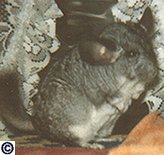
From Chinchilla Chat Line’s Memorial to Chuffy
“You may remember this little lady who was advertised on our rehoming page a while back. Chuffy had lived with her owner for six years, this owner admitted that Chuffy had rarely left her cage in all this time and then she decided she no longer wanted her. Mandy from Plymouth was the kind lady who rehomed Chuffy and they lived together for almost a year. Poor Chuffy always suffered from various health problems though and despite Mandy’s best efforts, Chuffy was put to sleep on the vet’s advice a few days ago. Mandy is very upset but she did all she could and certainly gave Chuffy a happy final year. Roger looked after Chuffy for a little while before Mandy came along and he had never come across a chinchilla quite like her, she was extremely tame and would sit in his lap for hours. Here is Mandy’s tribute to a brave little chinchilla.” ~ Introduction to Mandy’s poem by Chinchilla Chat Line
My little Chuffy – in the corner on her own. She must have ached to be allowed to roam.
For six long years in prison, Chuffy stayed. Slowly her life was ebbing away. She lived in an empty cage with a rusty base, no shelf in sight, no morsel of delight – on her own from morning until night. Little Chuffy had no pleasure at all. Her owner was worried that if let out, she would chew everything in sight. No mortal sin, we would say, just put things away so that she can run and jump and play!
But no-one wanted to put things away so in her cage Chuffy stayed whilst the days slowly passed away, nothing to do, nowhere to play inside her cage.
The damage was already done when I came along to give her a good home. Chuffy couldn’t run, she couldn’t jump, she even had problems judging heights. She was very stiff and wobbly too, exercise made her blue. Soon the illnesses started pouring in, her life was looking very grim. All those years she spent inside haunted her and made her cry. She would nestle snugly in my arms for one or two hours at a time. I’d kiss her nose and she would nibble mine. Lots and lots of cuddles we shared.
She was far too poorly for exercise, I’d sit with her and cry and cry thinking about all she had been through so Chuffy I am writing this poem for you.
Never ever have a chinchilla and force him/her to be a prisoner. Play outside the cage is a must for the chinchilla to thrive and become robust. It’s not too hard to hide chewable things away and let them have an hour’s play. Playtime was too much for Chuff, her little body had had enough. All those years of being caged has now taken her life away.
In loving memory of my Little Chuffy.
~ Mandy Elliott
Chinchillas are prey animals in the wild and it is true that they do appreciate some routine and tranquility in their domestic lifestyle, however, monotony, a lack of activity, and an environment without interest or enrichment are definitely not in their best interests. Environmental stimulation is important in moderate amounts, it keeps the bright, inquisitive chinchilla mind occupied when they’re not actively engaged in out-of-cage exercise or interaction with their chinparent.
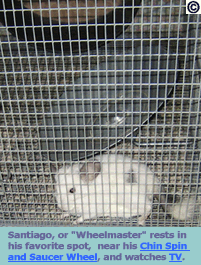
Chinchillas truly enjoy both music and TV, see The TV Attraction, TV during waking hours goes a long way in helping chins cope when they’re stuck in their cage as opposed to being allowed out to play. Mild music styles, such as bossa nova, jazz, blues, soft rock, classical, celtic, folk and reggae are good anytime, and especially soothing when played softly in the background during sleeping hours. A LARGE cage to accommodate running and playing, a variety of chew toys, at least one hideaway per chin and a cage wheel will help decrease tension and boredom inside the cage, preventing stress-related health and behavioral problems as well as cagemate conflicts.
Chinchillas are treasured as pets for their affectionate, sociable personalities, their keen intelligence and abundant playfulness, all of which comes to life when they receive regular exercise, interaction, and an environment that stimulates their senses and engages their mind.
Exercise For Breeding Chinchillas
Whether using a polygamous or a paired breeding system, regular exercise is essential to both the breeding male and female’s health and well-being. Females in breeding should have out-of-cage exercise without their breeding collar. Pregnant or nursing females that get (always observe precautions!) some out-of cage exercise with human bonding time will be less stressed and will model a positive, receptive attitude toward people that in turn will affect their kit’s ability to bond with people. Overly-stressed chinchilla mothers have been known to snap at their kits, sometimes causing injury, and being forced to remain in the confines of their breeding cage without any relief from the constant demands of their young can push some mothers over the edge.
Obviously, there are times when a breeding female needs to be near her young and shouldn’t be separated from them, a responsible breeder will know when it’s appropriate to let the mother have some relief and when not to interrupt the mother and kit’s bonding and nursing times. When a breeding program is focused on having and producing healthy, well-socialized chinchillas, then EVERYONE benefits: the chins who have their health and appreciate the company of the people who care for them, the adoptive chinparents whose pet is a source of joy rather than being difficult and sickly, and the pet breeder whose healthy, well-socialized chinchillas are a credit to their breeding program.
Chinchilla Chat Line’s Advice
“I and John Bower (Veterinary Hospital Group) concur in this: whatever pet, from a stick insect to a horse, must have a lifestyle to mimic what they would have in a wild state. Essential to this is what I term ‘external exercise’. All should have this experience on a day to day basis. Even a fly or spider may travel miles during one day, so captive animals (pets) must have the chance of exercise, not only to improve fitness but also psyche.
“Pregnant animals having exercise will improve their terms and produce healthier offspring which, after birth, delight in exercising outside the restricted accommodation and site of their play environment. Opportunities given to offspring for external exercising (from practically the minute they are born) makes for a better pet in later life. Fur biting and spinning around in a comer, huddling up in a crouched position, shaking of the head from side to side, lots of sleeping (unless ill or in advanced pregnancy) or general lethargy, are all indications of a bored creature which needs the stimulation of exercise and adventure, so plenty of things to do should be offered within the exercise areas. For a happier, healthier pet, I cannot over-recommend external exercise.”
Out-of-cage Exercise Time
Chin-Proofing and Other Precautions
Under normal circumstances, healthy chinchillas of any age (kits should be big enough to be away from their mother for extended periods of time) should be able to enjoy as much out-of-cage exercise as they’re allowed. Chinchillas need DAILY attention and interaction, and if a chin’s only opportunity for exercise is out-of-cage playtime (if he has no exercise wheel), then he will need AT LEAST a full hour of that every day. Even with an exercise wheel, he will still need out-of-cage exercise AT LEAST every other day for an hour (or more!) each time. The more exercise and interaction a chin gets, the more healthy and socialized he is and the more loved he feels.
Some people have mistakenly blamed exercise for playtime seizures as well as accidents associated with not chin-proofing, supervising, or acknowledging territorialism. However, when bad things happen during exercise, exercise itself is NOT to blame! It is the chinparent’s duty to assume responsibility and observe basic precautions so that their chinchilla can enjoy the exercise and freedom he deserves. As long as the following precautions are observed, the out-of-cage exercise time can be safe, beneficial to your chinchilla and… THE BEST TIME FOR BONDING WITH YOU!
Territorialism: Chinchillas Are Territorial
Basic Points
Always introduce chins before cohabitation to prevent potentially deadly fighting, and never use an introduction method that will threaten their sense of territorialism or put their safety in jeopardy. Some chins are much more territorial than others, it varies by the attitude and behavior determinants, e.g., whether a chin is easy-going or high-strung, whether or not he is accustomed to having chins outside of his group near his territorial range, or whether he was attacked in the past by another chin. Sometimes when chins are relocated, to either a new cage or a new home, one may barricade, staking territory, and that can instigate conflict.
It is not safe to assume that your chin/s aren’t territorial, if you have more than one bonded group it is your responsibility to take precautions that will accommodate and respect their territorial instincts in order to prevent things like: territorial anxiety (and excessively marking territory with urine), persistent or aggressive dominance mounting that can lead to cagemate conflicts, or anti-social (biting, urine-spraying) behavior that some chins may direct at their chinparent to convey their extreme stress and agitation.
Scent and the Sexes
Contrary to myth, male groups and female groups can coexist in the same household, provided that they don’t come into direct contact with each other or with each other’s physical excretions (urine/ urine marks, fecal droppings, estrus or mating plug, etc.), and that they are prevented from seeing each other per explanation in the other four points. Behavior can be an indicator of gender, like urine-spraying being a mostly female behavior and reproductive mounting being a male behavior, but gender is confirmed by scent and this is only discernible by direct olfactory contact (and possibly by tasting another chin’s fecal droppings) with the other sexes’ physical excretions or from putting their nose to another chin’s bottom for a sniff.
Adequate ventilation and air circulation, which are basic to chinchilla housing in general, will prevent the possible accumulation of urine scent (which is not normally pungent unless cleaning is inadequate) to the point where it is detectable and potentially problematic.
While awareness of the presence of the opposite sex doesn’t seem to have an affect on the social order of all-female groups, it does affect males, especially unneutered Alpha males with their strong dominance and mating drive. Once the presence of the opposite sex is realized by an all-male group, it can lead to their competing for the right to mate by subjugating their cagemate/s, and this is done by dominance mounting. If the dominance mounting gets persistent or aggressive, it can result in retaliation (fighting, sometimes to the death) by the antagonized cagemate/s. In the case of an M/F group, the male will be inclined (less so if neutered, more so if not neutered) to mount his female/s in order to reassert his authority and control in the group.
Direct contact with scent is necessary for it to be potentially problematic, and scent is not detected when cages are covered, or between rooms or at the other end of the house. Most online advice derives from pet breeders who don’t cover their cages, but we have covered cages since 1997 and even though the sheet around the cage catches that group’s urine (scent) between changings, we’ve never had a problem housing unneutered male groups (we’ve worked with hundreds of chins) right next door to females provided that these four points regarding territorialism were observed.
Out-of-cage Playtime
Only let bonded cagemates out together for out-of-cage exercise time, DON’T MIX GROUPS. Chinchillas do have a social order and mixing groups (especially opposite sex groups) will cause confusion and instigate conflict. If different groups use the same playroom, sprinkle Baby Cornstarch Powder or Arm & Hammer Baking Soda (not talc, it’s carcinogenic) on carpet urine stains and then vacuum the room well between uses, this will also remove fecal droppings. Clean the carpet periodically.
Chinchillas do have a territorial range or “comfort zone” that extends a few feet out from their cage in the directions they can see, and by instinct they want to guard and defend that immediate territory. For this reason, DO NOT USE THE CAGE ROOM AS A PLAYROOM! An outsider (intruder) wandering near other cages is in danger of getting bitten on the nose or toes, sometimes as a result of being encouraged to come closer (with ostensibly friendly baiting) by the irate caged chins, and the intruder’s presence can instigate persistent dominance mounting (and fights) as the lead chin in the caged groups attempts to reestablish social rank and control in response to the territorial violation.
Cage Environment
We recommend covering cages also see that section for more on preventing problems related to territorialism: “A barrier between cages prevents knowledge of (and contact with) the opposite sex or other chinchillas right next door. This is a PROXIMITY and SIGHT issue, it’s not about scent unless the chins are in direct olfactory contact with each other’s physical excretions (urine/ urine marks, fecal droppings, estrus or mating plug, etc.), or are able to put their nose to another chin’s bottom for a sniff.
“Seeing other chins across the room or more than a few feet away is normally not a problem, but seeing them camped right next door often is. Calm, easy-going, and not very territorialistic chins that are accustomed to this may not care, but even they may have a problem if they get different neighbors. Chins that are more territorial, high-strung, or not accustomed to having other chins right next door and who are suddenly confronted with this territorial violation may get very nervous and upset, exhibiting territorial anxiety (and excessively marking territory with urine), persistent or aggressive dominance mounting that can lead to cagemate conflicts, or anti-social (biting, urine-spraying) behavior that some chins may direct at their chinparent to convey their extreme stress and agitation.”
Chin-proofing
Chin-proofing is for preventing foreseeable accidents, playtime supervision is required for preventing the unforeseeable. The chin-proofed playroom needs to be large, about 12’x12′ or more, to accomodate running, jumping, and ricocheting off the walls. If there is nothing to interact within the chin’s play area then he will quickly become bored and begin gnawing the walls or looking for mischief. Chins need playthings (cat towers, wooden boxes, tubes, etc., see supplier sites, avoid chewing hazards) for exploring, perching, hiding under, and so forth to prevent boredom. Be creative and expect to change playthings periodically to maintain interest.
Tile, wood, linoleum, or other smooth floor surfaces are not suitable for a playroom because they don’t provide traction for running and this can lead to accidents and injuries; they may also be easily stained by urine. Carpet is soft, provides traction, and urine stains are easily removed with regular soap and water. You can put out a pan or tray in a corner of the playroom that contains some of the chin’s used litter, this may “litter train” him so that he urinates there during playtime, but not all chins will take the hint. Chinchillas continually leave fecal droppings that are small, hard, odorless, and easy to vacuum up; we have never heard of chins being trained to control that function.
Bathrooms sometimes appeal to people as an easy place to chin-proof for playtime, but they are not a good place to exercise chins for several key reasons: firstly, the typical bathroom is far too small for any real exercise to take place. Even when the toilet lid is put down and sharp (razor) or heavy objects (shampoo bottle) are removed, bathroom floors and fixtures, like the tub ledge, are too slick and slippery for chinchilla feet to get a grip on and avoid serious injury. Bathrooms are frequently damp and humid from shower use, creating prime conditions for mold and fungus growth which may go undetected by a human but will be readily discovered by a curious chin. The chin pictured below escaped from the playroom and went into the bathroom, where she found a crevice under the sink and hid until she decided to come out on her own.
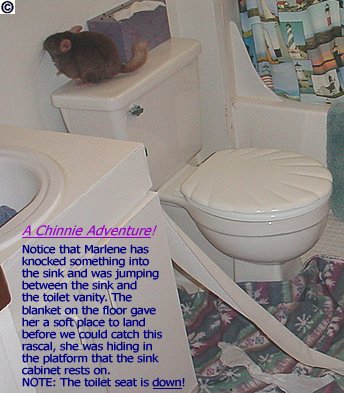
The chin’s playroom should have no electrical cords or other chewing hazards, but in the event that that’s unavoidable, wrap those things (furniture, cords, plastic, etc.) in towels or sheets (no strings, fringe or loose weave) in a secure manner (safety pins or duct tape can help, also see cord protectors) so that the chin can’t move it aside, otherwise he WILL eventually get around or behind it. Furniture only needs to be covered around the base and legs, not the entire unit. It’s a good idea to get on the floor and look around the room from what will be the chin’s point of view, it can lead you to secure things you wouldn’t have noticed otherwise.
You can try spraying pet “training aids” such as Fooey or Bitter Apple along baseboards (skirt boards) or window sills to help prevent gnawing there, people have had varying degrees of success with these and they have to be reapplied between playroom uses.
The door must be kept shut and notice should be posted on the other side alerting those who would open the door to proceed cautiously, there is a chin playing inside.
Don’t assume because your chin doesn’t immediately start gnawing,
that he’s “not a chewer” and won’t ever do so during playtime because…
There are PHASES of exploration:
- Scouting can take anywhere from just the first time in new territory to several sessions, depending on the chin and how many items there are to explore in the room. The chin will thoroughly explore everything, making note of the position of objects therein (chins “map out” their terrain and store that in memory rather than depending solely on sight, later this map enables them to maneuver effortlessly at top speed) and their attributes, how they can be used for fun. A chin may tend to stay under furniture and keep a low profile at first until he gains knowledge of the room and confidence in his ability to master it. Eventually, he’ll prefer high places that give him greater leverage from which to anticipate and react in his surroundings, and he’ll make note of tight places that will allow him to hide out of sight when he wants to.
- Gnawing occurs when the chin becomes better acquainted with the objects in his playroom and is ready to test their chewing potential. Chinchillas are rodents and they gnaw to keep their continuously growing teeth filed down, they also may gnaw recreationally as a way of exploring their environment or to satisfy their curiosity. Whether a chin gnaws seldom or voraciously depends on the individual, but because gnawing is a basic instinct chinchilla cannot be reliably trained to refrain from gnawing at certain times or places (they’ll just gnaw softly or when you’re not paying attention). They assume, and rightfully so, that their chinparent has secured whatever should not be gnawed on, and therefore anything they see or can get into has been presented for their gnawing pleasure. Place a small food dish and water dish (chins should normally use a water bottle but during playtime, they can adapt) in the playroom to help lessen the instinct to test everything for potential edibility.
- Mischief-making occurs after the room has been scouted and tasted. Then it’s time for an in-depth analysis, to see if there’s anything left to explore like hiding spots or something that wasn’t properly chin-proofed. THIS is the phase when the chinparent is most likely to be caught off-guard, this phase is the true test of chin-proofing. Just when you’ve assumed that the chin “can’t reach” certain exposed electrical cords or “isn’t interested in” something he shouldn’t gnaw on or “won’t fit” behind or under something in the room, suddenly, there he is… If your chin is getting into something that he shouldn’t, snap your fingers or clap your hands once or twice and say “no” in a firm, not loud or frightening, manner. Use this tactic sparingly or its effect will diminish.
Supervision

UNlike with such pets as dogs or cats, a chinchilla’s out-of-cage activity MUST be supervised at ALL times to prevent unforeseeable accidents. Inside the playroom, move slowly and shuffle your feet to prevent accidentally stepping on your chin. This is extremely important because some chins are especially fond of chasing feet, racing between and around them. Also, pay constant attention to where the chin is at any given moment because a chin who’s really enjoying his playtime can jump or make a sudden mad dash without perceiving the danger of being underfoot. It is generally inadvisable to allow other pets to have access to your chinchilla during his out-of-cage exercise time. A larger pet may get overly excited from watching the chin race about and rough play and accidents could ensue.
Pre-existing Conditions
We have discussed this with our exotics specialist vet who agrees, out-of-cage exercise is undeniably necessary and beneficial but problematic pre-existing conditions can manifest themselves during exercise. For instance, a playroom that’s too hot/humid can cause heatstroke, and a blood sugar imbalance from the consumption of sugary treats served around playtime, an hour before or after, can cause seizures.
Just as a person who has underlying health problems- say, a weak heart or diabetes- may collapse while exercising in their condition (or as a result of imposed conditions, like a hot playroom), the same can happen to chins, but once the pre-existing condition has been successfully addressed, exercise is once again safe and purely beneficial. Note that when chins stretch out on their side after a good run, this is not a sign of “overexertion,” it’s as natural as a person who stretches out on a beach or lawn after they’ve had a long jog; it’s just relaxing.
If your chinchilla has a seizure during playtime, wrap him snuggly in a lightweight towel or blanket (no strings, fringe or loose weave) and take him to your exotics specialist vet for immediate examination. While there, troubleshoot with your vet to determine and treat the REAL problem, the underlying cause of your chin’s seizure; the seizure itself is only symptomatic. If seizures during out-of-cage exercise (or any other time) happen frequently with the chinchillas in your care, then something in their husbandry or environment is seriously wrong and needs immediate attention.
We have been chinparents since 1997 and have worked with hundreds of chinchillas from all backgrounds, including rescues that came from serious neglect and ranchies who had no experience with out-of-cage exercise prior to coming to us. We often exercise our chins for hours at a time, and we have never had a single playtime seizure in all these years. Seizures aren’t that common, but awareness is key to preventing them, and there are many potential causes.
Pointers for avoiding problems caused by pre-existing conditions:
- A chinchilla should always have an initial vet exam to determine his state of health. Sick, injured, or post-operative chins should not be given out-of-cage exercise time without the express permission of your exotics specialist vet.
- Pregnant or nursing females should be watched over very protectively and especially in the case of a nursing mother, should be given shorter periods of out-of-cage exercise so as not to interfere with their maternal role.
- Temperature control in the playroom is imperative, high heat and/ or humidity can easily lead to heatstroke or seizures because a chinchilla’s body temperature increases somewhat during exercise, making them more susceptible.
- Malnutrition can cause seizures.
- Chinchillas should not be given sugary treats (raisins, etc.) too much or too often, ESPECIALLY around playtime (an hour before or after), as this can lead to a blood sugar-related seizure. If “rewarding” your chinchilla is your way of getting his cooperation to come and go from his cage, try a healthier treat that is not high in sugar.
Chinchilla Eyesight and Agility
Sometimes a chin can be just plain clumsy, but if he frequently runs head-first into objects in a setting that’s familiar and basically unchanged, and if he often follows the outline (furniture or baseboards) of the room when running about, then there is an eyesight deficiency at hand, perhaps blindness. Cataracts may or may not be present, they’re most often found in seniors and appear like a cloudy film over the dark part of the eye, reducing visibility and potentially causing blindness.
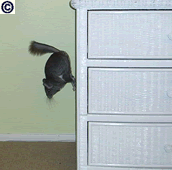
A chinchilla’s eyes aren’t used as much in navigation as a day dwelling animals would be. Chins rely strongly on their long, sensitive whiskers and their ability to mentally map out their environment so that they can practically cruise with their eyes closed by night. When chins are unfamiliar with their surroundings, if they have changed or are new, they will normally take time to mentally map out the area. If they just start racing about first off, then expect some collisions. Our first chin, Ryo-Ohki, would go slowly around a new room, checking out every nook and cranny before doing laps at rocket speed, her grace and agility were flawless.
If your chin escapes from you during out-of-cage exercise time and you do know where he is hiding at, try to block-off or isolate the area and ensure that it is chin-proofed, for when the chin does come out of his hiding spot.
Say he’s in the bathroom, for certain, maybe under the sink cabinet. Close the door, put the toilet seat down and unplug and remove (from the room) everything that has an electrical cord or is sharp, such as a razor or nail clippers. Also remove anything that is heavy (shampoo bottle, bubble bath, etc) that sits around the tub periphery- because if the chin gets out, he’ll explore and you don’t want him jumping around the tub and knocking into something that could land on his head. The ChinCare webmasters can speak from experience there- chins ALWAYS head for the bathtub!
If the floor is not carpeted you can place a blanket on the floor so that if he does leap about, he’ll have a soft place to land. Eventually, he’ll come out of his hiding place and you’ll either hear or see him- just remember that if you must open a door, do so VERY cautiously and block the entrance to his hiding place with your hand before he can run back in.
If a Chin Is Stepped On
If your chinchilla is accidentally stepped on during out-of-cage exercise time, DO NOT feel him over to detect injury, that can cause further damage. Also, don’t waste time on forums soliciting advice from non-professionals or prodding the chin to see if he’ll be responsive to treats or stimuli. DO immediately wrap him gently in a blanket (not a heavy one if it is warm outside) to restrict movement until he can be examined by your exotics specialist vet, the blanket will also keep him warm if he’s in shock.
Try to get someone to drive you to your exotics specialist vet or to an emergency vet clinic so that you can hold the chin securely to keep him from being jostled on the drive there. If that’s not an option, put him in a carrier, blanket, and all to help immobilize him, and drive carefully but quickly. The chin must be x-rayed. As prey animals, they naturally try to mask pain or injury and may not show the extent of the damage done by responding with sounds or reflex when professionally checked over, an x-ray is absolutely necessary for a thorough examination.
Once the vet has determined a course of action for recovery and the chin is back home, he will need a single level cage for the recovery process if he has any broken bones. ALLOW HIM TO REST undisturbed, don’t expect him to act lively or eat much, that is normal, let him recuperate in peace. Contact the vet immediately if he stops eating, drinking, urinating, or pooping for more than twelve hours.
The recovery setup should be located where it is relatively quiet and peaceful, away from prying pets, excessive traffic, etc. Cover his cage with a sheet for privacy and security. Some soft music, hearing your voice is gentle and soothing tones, and having you spend time near his cage to give him moral support will keep stress levels low and expedite recovery. TV is a MUST during his waking hours, this will help him endure the otherwise torturous boredom of the recovery process.
Related Video:

